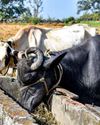Try GOLD - Free
National Saffron Mission Has It Addressed Saffron Decline in Kashmir?
TerraGreen
|January 2024
In this article, Athar Parvaiz says 12 years on, Kashmir's climate-sensitive saffron is yet to get sprinkle-irrigation under National Saffron Mission (NMS). The NMS, launched in 2010 to rejuvenate saffron cultivation in Kashmir by helping counter erratic rainfall among other challenges, is yet to ensure reliable sprinkler irrigation for saffron crop, the most basic requirement for the crop which is extremely sensitive to climatic conditions such as droughts. Irrigation plays a crucial role in saffron productivity. Farmers say that they heavily rely on natural rainfall for getting a satisfactory saffron yield.
-

Amid Kashmir’s red gold (saffron) cultivation facing erratic weather patterns and prolonged drought cycles owing to climate change, the saffron growers in the saffron belt of Kashmir (Pampore) say that even the much-publicized multi-billion rupees National Mission on Saffron (NMS) has not ensured a reliable sprinkle irrigation system for their saffron fields— irrigation plays a crucial role in saffron productivity.
The 4.1 billion rupees NMS, launched in 2010 to rejuvenate saffron cultivation in Kashmir is yet to ensure reliable sprinkle irrigation for saffron crop, the fundamental requirement for the crop, farmers complained. Implementing sprinkler irrigation in saffron fields, which traditionally relied on rainfall, was a key objective of this mission. The NMS was due to end in 2016 but has since been extended, though most of the works under this mission have been completed according to the officials of agriculture and irrigation departments.
Saffron farmers, who grow the “king of spices” in fields sprawling across several thousand hectares mainly in south Kashmir’s Pampore, have complained for years that lack of rainfall at crucial times has led to a decline in saffron production—adding that things are getting worse.
One or two spells of rain in September and October are vital for the crop to flower, farmers feel. “But in most years since the late 1990s, it either hasn’t rained in those months or has rained too much,” said farmer Mohammad Reshi adding that farmers still rely on how the weather behaves in the cropping season.
This story is from the January 2024 edition of TerraGreen.
Subscribe to Magzter GOLD to access thousands of curated premium stories, and 9,500+ magazines and newspapers.
Already a subscriber? Sign In
MORE STORIES FROM TerraGreen

TerraGreen
Sea Turtles are Doing Well, But Threats Still Loom!
A comprehensive 16-year report by the Dakshin Foundation, IISc, and state forest department
3 mins
May 2025

TerraGreen
Global Plastics Treaty Challenges and Way Forward
In this article, Arvind Kumar discusses the ongoing global efforts to tackle plastic pollution, specifically the negotiations surrounding the Global Plastics Treaty.
8 mins
May 2025
TerraGreen
Back to the Wild Two Greater One-Horned Rhinos Free-Ranged at Dudhwa Tiger Reserve
The Uttar Pradesh Forest Department has reintroduced two more greater one-horned rhinos into the wild at Dudhwa Tiger Reserve. This translocation effort, aimed at establishing free-ranging rhinos and enhancing their population in India's Terai region, was carried out on March 27, 2025, with the support of government officials, field personnel, veterinarians, rhino specialists, and mahouts.
2 mins
May 2025

TerraGreen
A "People's Plan" Launched For Conserving the Biodiversity of Arunachal Pradesh
The \"Arunachal Pradesh State Biodiversity Strategy and Action Plan: People's Plan\" was launched by the Honourable Chief Minister of Arunachal Pradesh, Shri Pema Khandu in Itanagar recently. The Action Plan has been developed by the Arunachal Pradesh Biodiversity Board and WWF-India to guide the state to sustainably utilize its rich biodiversity while ensuring a harmonious balance between development and nature conservation.
2 mins
May 2025

TerraGreen
Striking White Gold! How a Himalayan village found a steady source of income in a basic commodity
Once plagued by the phenomenon of emigration, Rautu ki Beli, a hill village in Uttarakhand, now witnesses its natives returning and making the village their home once again. A major factor behind this homecoming is the livelihood opportunity in the cottage cheese enterprise,Rakesh Agrawal narrates.
3 mins
May 2025

TerraGreen
Way to Upcycle! Parks feature monuments and structures made from upcycled metal scrap
Dinosaurs, Seven Wonders of the World, national icons and monuments stand tall in the nation's capital, New Delhi. Perplexed? Don't fret. Replicas of famous monuments, extinct species and national icons made from scrapped metal junk show how repurposing and upcycling is done, Sarita Brara writes.
5 mins
May 2025

TerraGreen
Reimagining Higher Education towards Sustainable Development in India
This article by Dr Debajit Palit and Dr Anandajit Goswami explores the challenges and opportunities of aligning Indian higher education with the Sustainable Development Goals (SDGs), with particular emphasis on SDG 4 (Quality Education) and SDG 7 (Affordable and Clean Energy).
8 mins
May 2025

TerraGreen
Back to Nature
In a nostalgic return to Jungle Hut in Masinagudi, Dr Marianne Furtado de Nazareth reflects on how the eco-conscious resort has evolved while staying rooted in sustainability.
4 mins
May 2025
TerraGreen
Can Nano-sulphur be a Game Changer for Oilseed Crops? A Case Study from TERI
To achieve edible oil self-sufficiency by 2030, India must boost oilseed productivity. However, declining soil sulphur levels―due to modern farming-are hindering yields, as oilseeds need high sulphur for oil synthesis and seed development. Nanofertilizers like nano-sulphur improve nutrient use, support plant growth, and reduce environmental harm. Replacing 25-50 per cent of traditional fertilizers with nanofertilizers yields results equal to or better than using 100 per cent conventional inputs. TERI has developed nanosulphur using a unique biogenic method, highlight Suneeti Singh, Palash K Manna, Alka Pandey, Maharaj Singh, Rajesh Narayan, Arvind Kapur, and Pushplata Singh.
3 mins
May 2025

TerraGreen
Exposure to Extreme Heat and Cold Temperature Leading to Additional Preventable Deaths in India
The authors of a new 19-year study are calling for immediate measures to curb the growing death toll from extreme temperatures in India. Over the past two decades, heatstroke has caused around 20,000 deaths, while exposure to cold has resulted in an additional 15,000 fatalities.
4 mins
May 2025
Listen
Translate
Change font size

